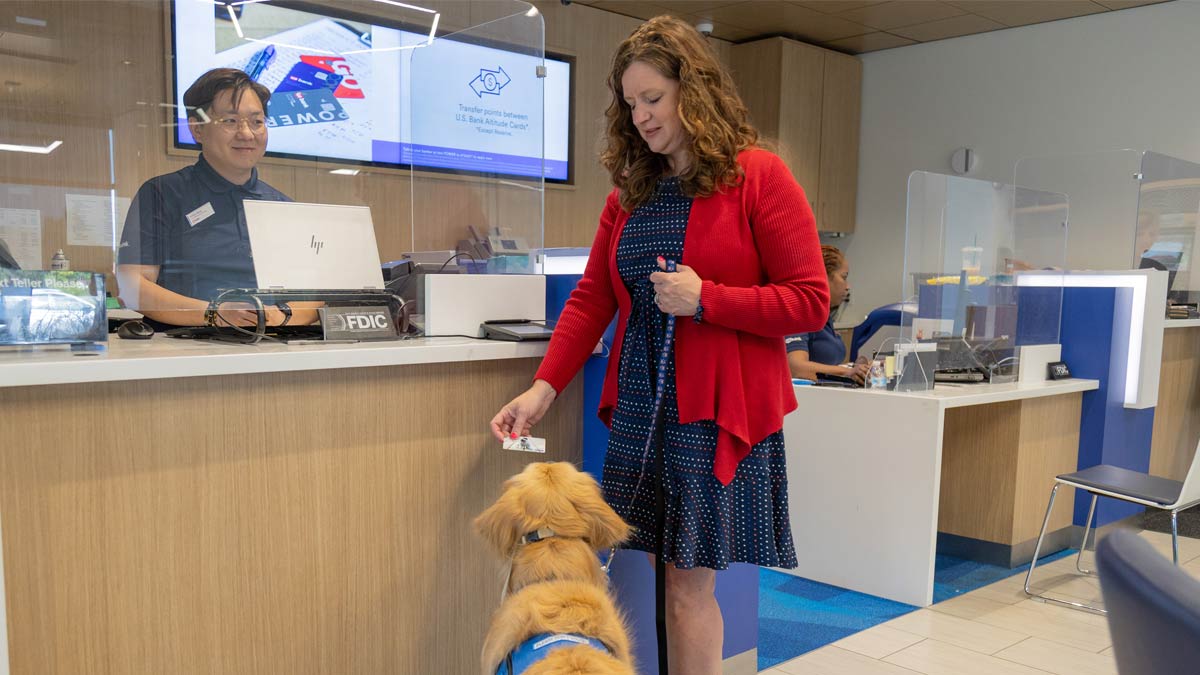Meet the Wealth Management Vice President Who Also Trains Service Dogs
Jolene Jackelen, vice president on the annuity product team at U.S. Bank, has volunteered with Helping Paws MN for 15 years, training service dogs to assist people with disabilities and PTSD. Jackelen, who has trained two service dogs, integrates this work with her role at U.S. Bank, bringing dogs to the office for training. Helping Paws MN, an organization that started in 1985, focuses on training Golden and Labrador Retrievers. Jackelen highlights the importance of service dogs and the distinction from therapy or emotional support animals. U.S. Bank also promotes digital accessibility in its services, integrating inclusive practices to benefit all users.
- Jolene Jackelen's dedication improves U.S. Bank's community engagement image.
- Helping Paws MN's partnership reflects positively on U.S. Bank's social responsibility.
- U.S. Bank's promotion of digital accessibility enhances user experience for all clients.
- The PR lacks concrete financial updates or business developments directly impacting the stock performance of USB.
- mention of quantifiable metrics or financial achievements related to U.S. Bank's main business operations.
Jolene Jackelen has volunteered with Helping Paws MN for 15 years, helping make the world more accessible for people with physical disabilities and post-traumatic stress disorder
Originally published on U.S. Bank company blog
NORTHAMPTON, MA / ACCESSWIRE / May 21, 2024 / Jolene Jackelen always loved dogs and always loved volunteering in the community. A chance encounter with a family friend in a grocery store 15 years ago set her on a path to meld the two passions.

"She had an assistance dog she was training, and as she told me about it I realized it was something I wanted to do, too," said Jackelen, who has gone on to volunteer thousands of hours and trained two service dogs through the nonprofit Helping Paws MN.
Training an assistance dog is no small task. It takes about two and a half years to teach the dog the 70-90 cues it needs to eventually help its owner further their independent living and quality of life, including opening doors, turning on lights and retrieving phones and other items. The dogs can brace to help someone stand up, or provide comfort during a nightmare. They are also trained to go get help. Once an assistance dog is matched to their owner, there's often additional training specific to that person's lifestyle - whether it's a veteran with post-traumatic stress disorder who wants to drive their kids to school with less distress or someone with a disability who needs assistance opening doors.
The training is "all about teaching the dogs the skills they need to assist their person, and training in a positive manner," Jackelen said. "The coolest thing about the human-animal bond is that the training prepares them for different things they may experience, but in real life you really see how the dogs intuitively sense the needs of their person and innately respond."
As part of the training for both of her assistance dogs, Jackelen worked with her manager and building management to secure permission to bring the dogs to the office once they reached the appropriate skill level.
"As part of the protocol for training, they had to learn how to work in an office, sit in a cubicle and not disrupt anything at work. Many, many U.S. Bank employees have met my dogs," said Jackelen, who trained her first dog at the West Side Flats office in St. Paul and her second at U.S. Bancorp Center. "The bank has been amazing in helping me - especially my boss and my colleagues. I've felt so much support along the way in training these dogs."
Eden Prairie, Minnesota-based Helping Paws began in 1985 as a pilot project at the University of Minnesota's Center for the Study of Human-Animal Relationship and Environment and became an independent nonprofit in 1988. The organization breeds and trains only Golden Retrievers and Labrador Retrievers because of their friendly dispositions, natural desire to work with people, retrieving instincts and large size that can provide a physical support if needed.
Jackelen started volunteering with Helping Paws by assisting with public access tests that service dogs go through, ensuring they can perform tasks while staying calm and focused. After about five years, she trained her first assistance dog, and then trained her current dog, Koho, a few years later.
Koho ended up unexpectedly becoming a demonstration dog because he finished training just as Covid-19 shutdowns began and was not able to be matched to a new owner. Instead, Jackelen now takes him "anywhere people want to learn about service animals," from schools to Minnesota Wild ice hockey games to U.S. Bank Business Resource Group (BRG) events held by the Proud to Serve veterans' BRG and the Disability BRG. She also volunteers as a class assistant in weekly dog training classes and is currently puppy sitting one of the newest service dogs in training.
At U.S. Bank, Jackelen is vice president on the annuity product team in Wealth Management. She's been on the team for 12 years, and finds similarities between her volunteer work and career at the bank. Both roles require a lot of organization and planning, she said, and an inherent desire to work with and help people.
"In wealth planning, you care about an individual and helping them plan for the future and achieve their goals for years to come," she said. "It's the same thing for training a service dog. You're helping people to be their best self, and fulfill their goals and dreams by allowing them to be more independent."
Jackelen on what to know about assistance dogs:
- Service dogs are different than therapy dogs or emotional support animals. Service dogs are the only ones covered by the Americans with Disabilities Act because they provide a specific service to help someone with a disability.
- When you see an assistance dog in public, ignore it. "Just think of the dog as a piece of working equipment that is helping that person. That dog is with that person for a need, and if you're distracting them from their work it's hard for them to concentrate."
- If you ask to pet an assistance dog and the owner says no, please don't be offended. "They're just asking the dog to focus on their job at hand."
- People often wonder if assistance dogs ever get to have fun, and the answer is yes. "Just like any other dog, they're very much a part of the family. But when they're in public, they're working."
Disibility inclusion is a digital priority
As more and more people do their banking digitally, U.S. Bank is leading the way in digital accessibility - enabling people to use best-in-class digital tools regardless of any disability.
Accessibility is a core part of the digital product development lifecycle from design to development. In fact, U.S. Bank has teams of accessibility experts dedicated to providing accessible experiences and products. These teams play a vital role in the creation of digital experiences by advising product teams, advocating for inclusive design, and training teams on the proper accessibility testing practices and tools to ensure our teams are testing for defects. To ensure all clients' needs are met, U.S. Bank conducts inclusive research studies that includes collaboration with clients who have disabilities themselves, following a motto that says: If you're going to make something for someone, make it with them.
One of the great things that happens with this approach is that our digital products not only benefit people with disabilities but are better for everyone. A terrific example of this is when we launched U.S. Bank Smart Assistant in our mobile app. Employees and clients with disabilities helped with the creation of Smart Assistant from the very start, and as a result, it was designed in such a way that not only helps clients with low vision, for example, but was easier to use for all clients.
Our digital accessibility team is passionate about what they do - at work and at home - and is proud of the difference their work makes in the lives of our clients.
View additional multimedia and more ESG storytelling from U.S. Bank on 3blmedia.com.
Contact Info:
Spokesperson: U.S. Bank
Website: https://www.3blmedia.com/profiles/us-bank
Email: info@3blmedia.com
SOURCE: U.S. Bank
View the original press release on accesswire.com
FAQ
Who is Jolene Jackelen at U.S. Bank?
What organization does Jolene Jackelen volunteer with?
How long has Jolene Jackelen been volunteering with Helping Paws MN?
What types of dogs does Helping Paws MN train?







